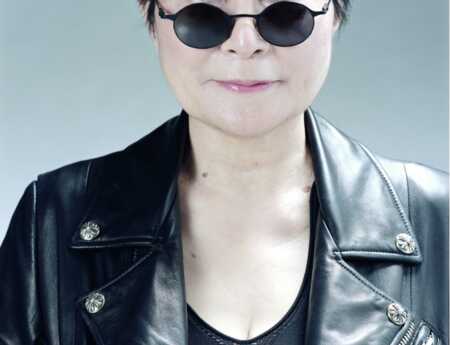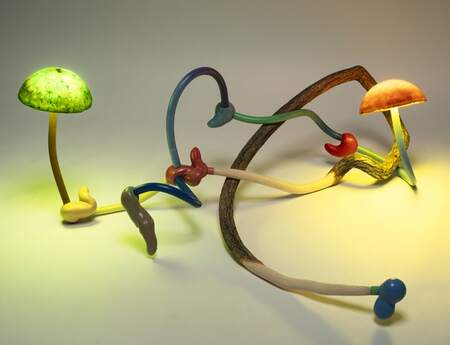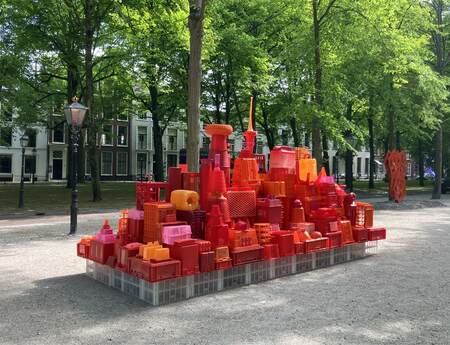der TANK
Freilager-Platz 1
4142 Basel/Münchenstein
Switzerland
Derek Tumala: Eyes Melted Gold (Natunaw na ginto ang mga mata)
Curated by Chus Martínez
Curatorial assistance Marion Ritzmann
Exhibition 14 – 22 June 2025
Special Opening
Tuesday 17 June 2025, 6 – 9 pm
As part of Art @Dreispitz
Tuesday 17 June 2025, from 5 pm
Atelier Mondial, HGK Basel FHNW with CIVIC and der TANK, HEK, Kunsthaus Baselland
Freilager-Platz / Helsinki-Strasse, Dreispitz, Basel/Münchenstein
Opening hours:
Saturday and Sunday 2 – 6 pm
During Art Basel: Wednesday to Sunday 2 – 7 pm
And by appointment: dertank.hgk@fhnw.ch
We talk about postcolonialism as if it were a state of the past. But it is a condition of the present. A condition that manifests in many forms: some appear almost like ghosts, others like super powerful events, like heat or sun strokes. Heat and energy are interrelated notions. Heat began to be perceived as an entity, a force, a power so present in the social fabric with the invention of the coal-fired engines. Heat could then move machines. Humans were there to extract the mineral and nourish the monsters that would activate the million forms of industrial production. Energy is a cousin of heat. To have heat in the body means you are overpowered, sexual, dangerous. Energy is more mellow. It started being used as a concept to refer to well-being only in the 19th century with the vitalist movements that arrived from America and expanded globally; good energy and bad energy. Being hot is being desirable. Being cold is not having feelings. The energy of the Earth got slowly transmitted to the humans in forms they did not know before. Now, heat is returning to the Earth. All these factories, and all these hot humans made the planet hot, so hot that even the Sun is unable to control its power, and it strikes. The start that is the center of life, of the planet, physically impacts the Earth’s surface and all its creatures and the human bodies causing damage.
The Sun is a central figure in Derek Tumala’s work and is, as well, a prevalent and symbolic force in Philippine mythology. At der TANK, three works interact with each other to create a hallucinatory environment: Fire Ants (2025), Forever Burning (2025), two videos, and Animal Apocalypse (2025), a series of reflective sculptures suspended in the air. Fire ants, an invasive species not native to the Philippines, came during the 17th century through Spanish trade from South America. Today, they are found everywhere in the Philippines—in kitchens, bedrooms, gardens—an insidious colonial legacy. The choices of creatures in Animal Apocalypse are based on the scientific concept of the “sixth mass extinction,” which we are currently witnessing. This approach implies that apocalyptic events have occurred five times before. Some animals in this series therefore have a symbolic significance. The Axolotl, for example, endangered due to rising water temperatures, is juxtaposed with the Tardigrade, which can survive extreme conditions.
A collaboration between the 36th Ljubljana Biennale of Graphic Arts and the Institute Art Gender Nature HGK Basel FHNW
bienale.si
With special thanks to Atelier Mondial
ateliermondial.com
The opening performance of Temple of Fire by Pilar Quinteros, who studies in the master’s program of the Institute Art Gender Nature HGK Basel FHNW, will take place on 17 June 2025 at 1 pm in the immediate vicinity of der TANK. The project curated by Claudia Perren and Chus Martínez is on view at the Freilager-Platz in Basel/Münchenstein until 30 August 2025. It is the second edition of Public Art@Freilagerplatz, a collaboration between the Basel Academy for Art and Design FHNW, HEK (House of Electronic Arts Basel) and the Kunsthaus Baselland.
fhnw.ch/hgk


